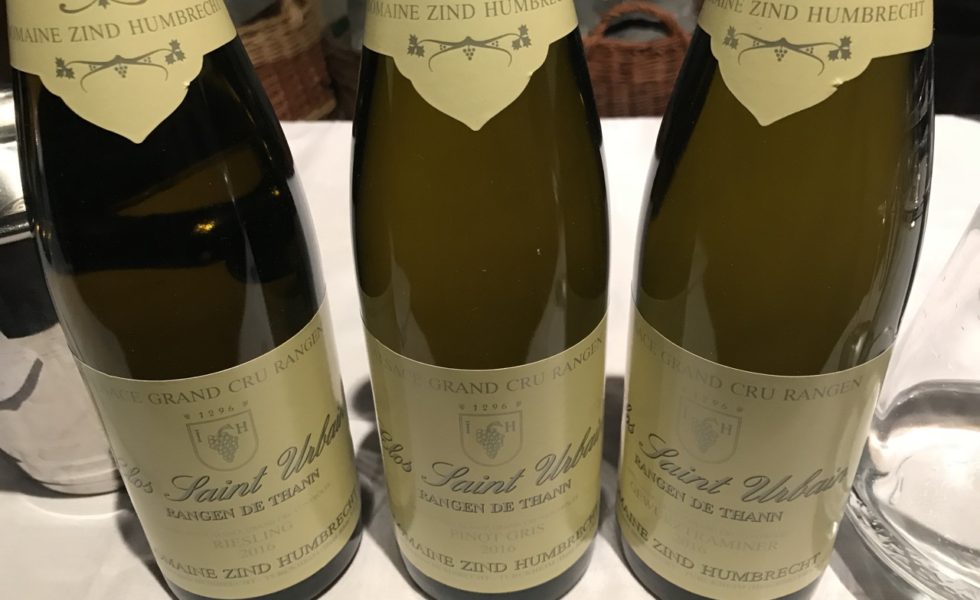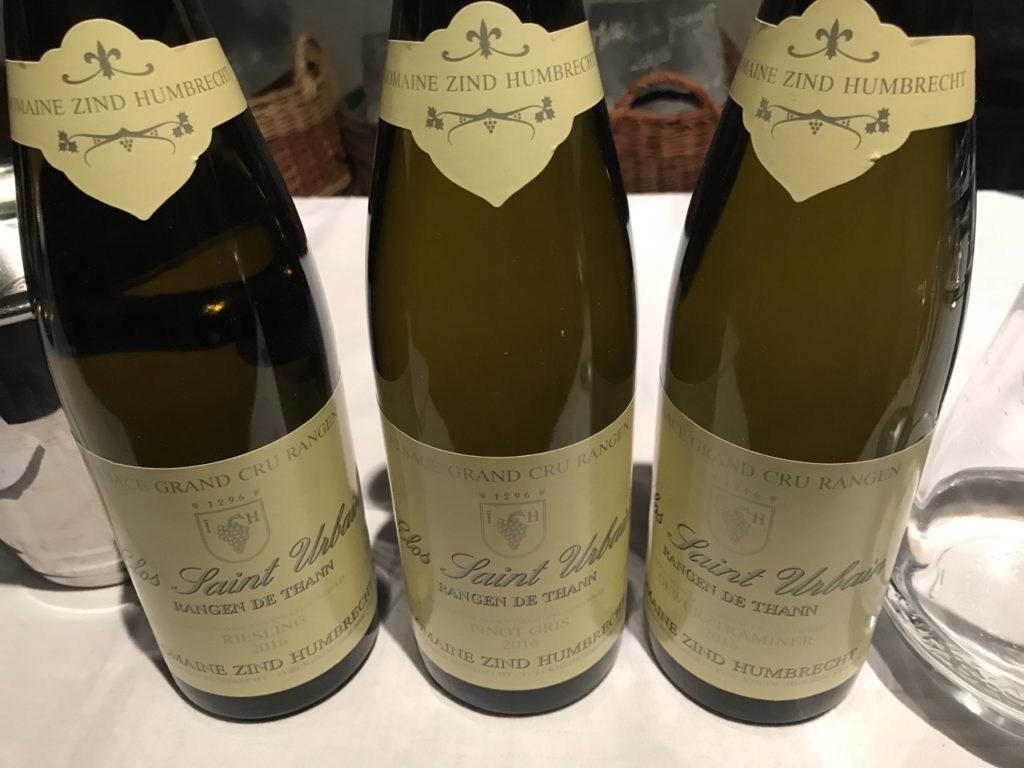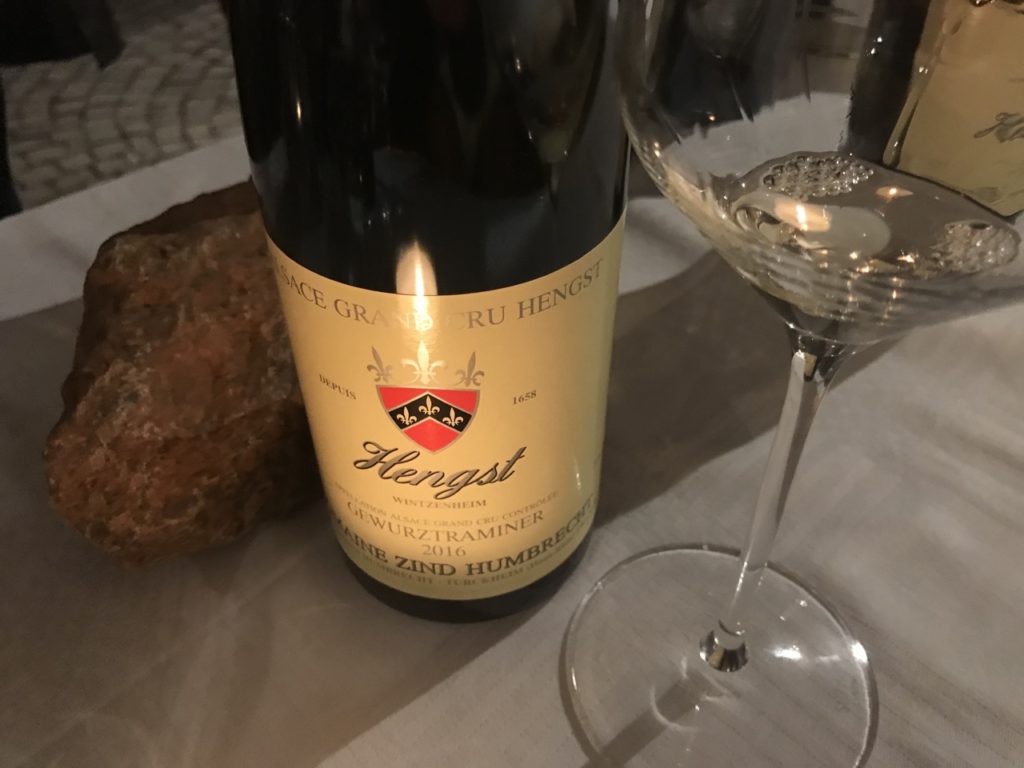Alsace 2016: the paradoxical vintage

Deceptively soft spoken Zind-Humbrecht
19 March 2018
By Panos Kakaviatos for wine-chronicles.com
Another year, and another chance to taste the fine wines crafted at Domaine Zind Humbrecht.
Known to produce some of the best Alsatian wines sold in both France and in international markets, Domaine Zind-Humbrecht also offers a “bird’s eye” view of each vintage in March with a very well organized tasting along with detailed vintage reports.
As you can read here, 2016 is “extremely contrasted.”
A mild and wet winter and spring allowed for a fertile bud break, but also caused disease problems (mildew). Summer and the ripening period to the harvest were arid and warm.
2016 thus “strangely” combines the characteristics of an early and late ripening vintage.
“There was a big bud break, with lots of clusters,” explains owner Olivier Humbrecht in the video below.
Yet with drought conditions in August – that threatened younger vines and vines on lighter soils – berries stayed very small, with a high ratio of skins to juice.” In the end it was “paradoxical” because while the grapes were ripe, they were also lower in alcohol: “We harvested relatively late, with much less sugar and alcohol than usual,” Humbrecht says. So there is a lot of wine with “beautiful, ripe aromatics but with lower alcohol,” often “between 12 and 13 percent,” he explains.
Elegance and refinement
When I tasted the wines at the domain this month, I was impressed by a general sense of elegance, purity and precision. Interesting to note the reaction of a non wine specialist in tasting these wines: her reaction was one of being “underwhelmed” by some of the Pinot Gris, for example. And I can see how that may happen for fans accustomed to richer – and more thickly textured – Pinot Gris. But these wines rather sang to me. First off, because they exude both finesse and subtle palate presence. But also because I generally favor elegance over thickness.
The Rieslings reflect a sense of subtle elegance and softer palate expressions that some tasters may not appreciate, initially. But suave substance comes across all of them. I bought several Rieslings after the tasting, including Brand. Of course strong showings from the flagship terroirs of Brand, Rangen de Thann (photo above), and Clos Windsbuhl, but other terroir-driven wines like Riesling Roche Granitique were also excellent.
As in recent years, the tasting was divided according to terroir, so that six tables featured wines made from grapes coming from specific soil types: from volcanic and granitic, to various types of limestone.
I also liked the finesse of the Gewurztraminers that seem to be better “food wines” in this vintage as compared to other vintages. Acidity levels (always somewhat low for this grape) are higher than average in 2016. One gets a “livelier” expression in 2016.
The Muscats? Also refined, although perhaps one could sense just a bit less “palate envelopment” in this vintage.
2016 was a success for the popular brand “Zind,” which combines Chardonnay and Auxerrois: smooth yet nuanced. I wonder if there is increasing depth in this wine as the vines – planted in 1988 – age more. I bought a few bottles and love the wine for its excellent QPR ratio.
The one caveat for 2016?
Fans of late harvest wines will have to deal with far less. Except for the Clos Jebsal, 2016 wasn’t a vintage for late harvest style wines.
Dear readers, please subscribe to these pages! It does not cost you anything but a click of a button – and you get updates on wine tastings free of any “industry influence” because I am an independent writer. And tell your friends. Thank you! ?
Tasting Notes
Tasting notes, all wines below are from the 2016 vintage. As usual, when bold, I liked in particular. If red and bold, even more. If underlined, too, a kind of wine nirvana.
Flight One: Gravely silts & granite
Muscat Turckheim: In 2016, most grapes took a long time to increase their sugar concentration, so it was possible to harvest ripe grapes with lower alcohol potential, which “suits this grape variety very well,” according to Olivier. A very smooth and focused Muscat, bone dry, with a refreshing aspect and palate that transcends your typical “grapey” Muscat wine taste. The alcohol is 11.9°, with just two grams of residual sugar and three grams of acidity per liter, so there is a crisp aspect to the wine that pleases. Its subtle nature may be beyond the comprehension of some drinkers, even if there’s a bit of mid palate “shyness” here. ? … 88/100
Riesling Roche Granitique: One of the few 2016s that evokes full-bodied richness with a juicy mid palate – and fine vivacity. Clocks in at well under 12.5 alcohol, but its high acidity is finely balanced by eight grams of residual sugar. Yields at 65 hectoliters per hectare. At just over €20 per bottle, an excellent deal for lovers of nuanced yet richly styled Riesling. 91/100
Riesling Brand Grand Cru: With an average to steep slope, oriented south and south-east, the Brand vineyard enjoys an exceptional amount of sunshine and is sheltered from the north winds, making it a warm and precocious terroir. Only Riesling vines, averaging over 60 years in age, are planted in Zind-Humbrecht’s Brand vineyards, which represents a surface of approximately 2.4ha. The expected finesse and elegance of floral and fruit aromas comes across very nicely in 2016, which reminds me of the 2013, but with a bit less residual sugar (3.5 grams of residual sugar as opposed to 4.2 in 2013) with somewhat comparable acidity. The nature of this terroir makes it easy to obtain optimal ripeness while retaining fine acidity (malic acid degrades more in poor soils and warm localities). At just over 13° in alcohol, with a low pH of 3.2 and 3.5 grams of residual sugar per liter, this exudes refinement and class, as well as mid palate substance: a burgeoning opulence that bodes well for cellaring. It is more expressive at this early stage than the Riesling Rangen de Thann (see tasting note, below) 95/100
Flight Two: Volcanic and sedimentary soils
Riesling Roche Volcanique: An even richer style than the Roche Granitique. At nearly twice less in yields (35 hectoliters per hectare), I did get a sense of more “generosity” on the palate, a more “ample” feel. It is just as refined and vivacious, if with a tad more precision! Could it be the lower residual sugar level along with (somewhat) comparable acidity? Maybe. In any case, this is one darn good Riesling to buy! 92+/100
Riesling Rangen de Thann Clos-Saint Urbain Grand Cru: The Grand Cru Rangen de Thann is the most southern vineyard in Alsace, situated at the end of the Route du Vin, and isolated from the rest of the Alsatian vineyards. With higher rainfall and higher altitude relevant to other vineyards in Alsace (350m to 450m above sea level), the terroir has a late ripening character that is somewhat offset by south facing slopes and exceptional exposition, allowing grapes to mature slowly into October and even November, thus making it possible to achieve high levels of concentration. The soil structure of this famous locality is unique in Alsace, made up of volcanic rocks and sedimentary sandstones with a varying abundance of volcanic elements. As I recall, the 2013 – of which the 2016 sometimes reminds me – has slightly lower alcohol than this vintage (12.5° as opposed to 12.8° here) and one gram per liter more of acidity. OK, the 2016 has five grams of residual sugar, while the 2013 has eight. So one gets the impression of finesse and elegance, along with full body, marked by white pear and wet stone notes, but it is slightly less evidently opulent compared to the 2013 at the time of its early tasting. In the inevitable comparison with the Brand Riesling, I find the latter a bit more expressive. But this wine should develop so well with cellaring, so score is conservative in this sense. 94/100
Pinot-Gris Rangen de Thann Clos-Saint Urbain Grand Cru: The acidic, well-draining, warm soils of the Rangen are also well suited to the (predominantly limestone grown) Pinot Gris. The fact that the Rangen naturally yields very small crops, without any manual intervention (green harvesting), adds to the success of Pinot Gris on these slopes. But here was a prime example of a non wine trade taster feeling a bit underwhelmed by the Pinot Gris, as she was expecting more thickness and richer intensity. But I was charmed by the subtle, sap driven expression of this grape, all rather diaphanous and graceful in expression. Sure, it clocked in at nearly 15° of alcohol, but you did not feel that. The residual sugar is under 2 grams per liter (the 2013, by contrast, had nearly 13 grams of residual sugar, with 13.4° of alcohol). Here an expression approaching more the terroir rather than the variety: the harmony and salinity of the Riesling is matched here by the Pinot Gris, and even if some tasters may scratch their heads, I think this is a very fine wine indeed. 93/100
Gewurztraminer Rangen de Thann Clos-Saint Urbain Grand Cru: What can I say about this one? Gorgeous. Just as with Pinot Gris, when Gewürztraminer gets too thickly textured and sweetish, I get turned off. This wine exudes wonderful spring flowers and white pepper like spice aromatics, followed through with a palate so subtle in its opulence. Less than two grams of residual sugar, and a pH of 3.5 reveal a brisk balance for this grape. Indeed, this trio of Rangen de Thann resemble each other more for common terroir characteristics than being differentiated by grape variety, but the Gewürztraminer has the most immediate appeal at this very early stage. 95/100
Flight Three: Oolitic Limestone
Muscat Goldert Grand Cru: Dry and very fine indeed! But as with the Muscat above: could the finesse aspect of the 2016 vintage come close to leaving the impression of lacking enough palate substance? Just about 12° of alcohol with 1.5 grams of residual sugar. Even the sleek and dry style of the 2014 vintage had more alcohol (12.6°), as did the 2013 (12.5°) albeit with six grams of residual sugar, which gave it a “bigger feel” a few years ago. I found the wine just a tad lacking in palate envelopment and length on the finish. I like the Grand Cru Muscat, I like its finesse, but not as much – as a whole – as in aforementioned previous vintages. 88/100
Riesling Roche Calcaire: This was another fine Riesling, but not quite as impressive as the Riesling Roche Granitique, which had more expressiveness about it. 91/100
Gewurtztraminer Roche Calcaire: The whopping 77 grams of residual sugar could be felt here, and I was not entirely convinced by the balance. Interestingly, my friend who was less excited with the Pinot Gris, just loved this wine. It is rich, to be sure, but the balance achieved by the Rangen de Thann Gewürztraminer is far more appealing to me. 87/100 (score higher if you like the style)
Flight Four: Oligocene Limestone
Riesling Heimbourg: Very similar indeed to the 2013, with the same level of 12.7° alcohol and same pH of 3.1, but with slightly less residual sugar. It comes across refined and elegant with an appealing wet stone aspect to the wine, quite iodine like and brisk, but somewhat closed in at this stage. I think it an excellent Riesling that just needs a few years in bottle for the early drinking window. 91/100
Riesling Clos Häuserer: This has the same elegance and refinement as the above but with more palate intensity and substance, at least it leaves that impression as fuller bodied. No doubt the balance of eight grams of residual sugar with just slightly higher total acidity than the above wine contributes to a broader aspect, but there is such yummy white tobacco to this, too. I could easily enjoy this with lobster. 93/100
Pinot Gris Rotenberg: Another excellent showing from Pinot Gris in this vintage, even if lower keyed than – say – the 2013, whose profile was 1.5° higher in alcohol. I just loved the focus here, with bright and juicy apricot fruit, made vibrant with excellent acidity to balance the six grams of residual sugar. 93/100
Gewürztraminer Hengst Grand Cru: This rivals the Rangen de Thann but on a more opulent level. What refreshing elegance from a Gewürztraminer, almost unexpected, along with the 27 grams of residual sugar. The spicy, refined flavors of cinnamon, nutmeg along with spring flowers and tangy peach are made more focused with relatively high acidity for the grape – the pH is 3.9 – and it is just lip smacking delicious. 95/100
Flight Five: Calcareous Muschelkalk (chalky soils over limestone)
Zind: For its price point, this blend of 65% Chardonnay and 35% Auxerrois is delicious, with herbal, vanilla and citrus aspects that not only accompany grilled chicken and fish very well, but are communicated with refined smoothness to the palate. Really, this is a no brainer and I bought several bottles. 91/100
Riesling Clos Windsbuhl: As with the Rangen de Thann, this terroir features three top Alsace grapes. Clos Windsbuhl is located on top of a small hill attached to the Vosges forest, just above the village of Hunawihr. Its location explains a late ripening climate, enhanced by the calcareous (Muschelkalk) soil. Anyway, the wine reflects yet again a “deceptively soft spoken” aspect of the vintage. The sheer precision of the wine is appealing: very long, refined and clean. But in this case, I would admit that it may not be as “present” on the palate as, for example, the 2013 was at a similar time in evolution. It is interesting to note how so very racy and substantial the 2013 was a few years back: it had 12.5° of alcohol as opposed to the 12° in the 2016. The 2013 had over double the residual sugar of the 2016, but not much more acidity, so we end up with a different balance. I just think that the 2013 – at this early stage – impressed me a bit more than the 2016. Still, this is a very polished and refined wine. 93/100
Pinot Gris Clos Windsbuhl: Tasting this along with my friend, I made the remark that this is a “Protestant” Pinot Gris as opposed to a “Catholic” expression. Well, it could even be described as ascetic. But I really liked the precision and freshness to the wine, from the nose to the palate. For example, again comparing with the 2013, you have 12.6° of alcohol in 2016, while the 2013 had 14.5°. Both with 10 grams of residual sugar. So in the end, you have a bigger style in 2013 even if the residual sugar is the same. 92/100
Gewurtztraminer Clos Windsbuhl: This may have been my favorite Clos Windsbuhl of the three, this and the Riesling. I could not believe that it has over 37 grams of residual sugar, such is the racy elegance to this wine. OK, not quite as expressive as either the Hengst or the Rangen de Thann, but still a darn delicious and refined Gewürztraminer. Spicy elegance. 93/100
Flight Six: Gypsum, grey marles and limestone
Pinot Gris Clos Jebsal Vendange Tardive: The rich marl in the Jebsal soil brings a cooling element, so there is no sense of heaviness and that is particularly true in this vintage, which has less residual sugar than normal. So you have sweetness yet balanced on a cooler side, with 49.1 grams of residual sugar (the 2012 and 2015 have 73). Excellent acidity brings structure and freshness. Some quince, white peach and honeyed aspects, but not so much botrytis spice. A very smooth, almost sleek, late harvest style. 93/100
Pinot Gris Clos Jebsal Sélection de Grains Nobles: An almost organic apple juice flavor combined with wet stone, exotic fruit and yellow peaches bring about an impression of a wine that is not so much “sticky” as refined: a key description for the vintage. Finesse indeed, with lower residual sugar (albeit also less botrytis) than in past vintages, at just under 129 grams per liter, but over 13° of alcohol. This is very fine SGN. 93/100
 Wine Chronicles
Wine Chronicles


Share This